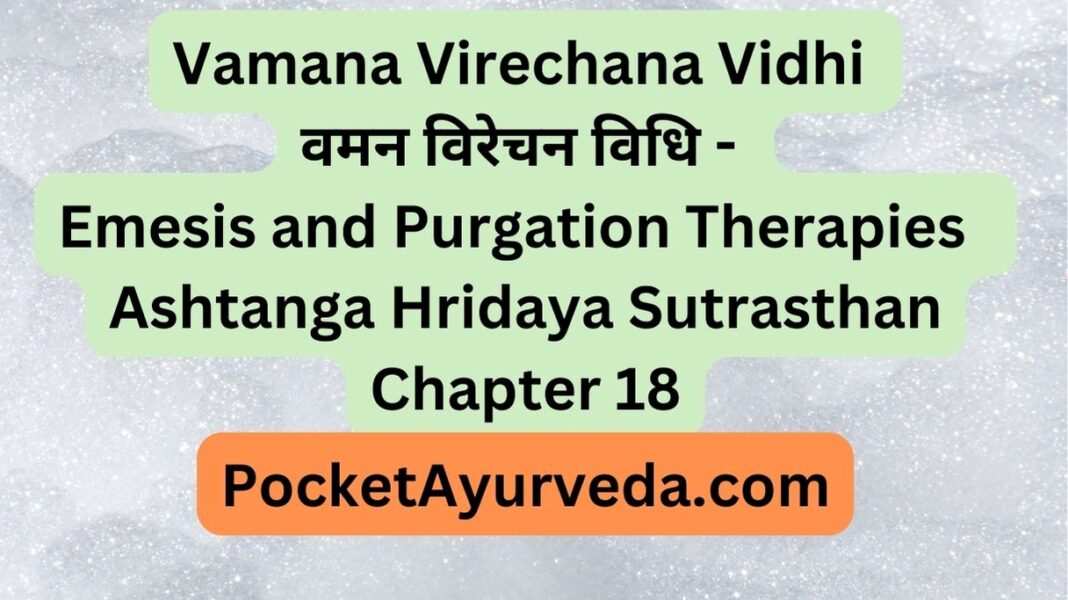Vamana as well as Virechana Panchakarma therapy will be described in detail in this article. Which people are the best candidates for these therapies, and who aren’t. What are the warning signs to look out for during the process as well as the possible complications and treatment options for these complications? It is the 18th Chapter of Ashtang Hridya Sutrasthana. It is known in the form of Vamana Virechana Vidhi Adhyaya.
Panchkarma as per dosha dominance


Vamana Emesis should be used to treat an increase in Kapha whether by itself or in conjunction with other Doshas when Kapha is the dominant.
Virechana Purgation should be used to treat an increase in Pitta either by itself or in conjunction with other Doshas in which Pitta is predominant.
Vamana Yogya – People who are suitable for Vamana Procedure
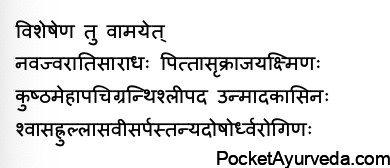

Vamana yogya – Which are the Persons suitable for Vamana procedure
The medication should be given to patients who suffer from Navajwara or a fever of recent onset
Atisara – diarrhea, dysentery
Adha: Pitta imbalance in the lower part of the stomach. Pittasruk – A bleeding disorder caused by Pitta imbalance Rajayakshma – Chronic respiratory disorder Kushta – skin diseases
Meha – the urinary tract, diabetes, and other disorders
Apachi, Granthi-Goitre, tumor, fibroid
Shleepada – Elephantiasis, Filariasis
Unmada – Schizophrenia
Kasa – cold, cough
Shwasa – Chronic respiratory tract disease Asthma
Hrullasa – nausea
Visarpa – herpes
Stanyadosha – vitiated breast milk
Urdhvaroga – neck diseases that affect and the region above 1b-2b
Vamana Ayogya – People who are not fit for Vamana Panchakarma -Avamya
Vamana Ayogya – Persons not suitable for Vamana Panchakarma
Garbhini – The woman who is pregnant,
Rooksha: people who are dry, have not undergone Oleation therapy, Kshudhita – hungry
Nitya Dukhita, who is always grieving,
Children, elderly people,
Krusha is the one who has been emaciated.
Sthula The obese
Hrudrogi – a patient suffering from heart disease
Kshata – the wounded
Durbala – weak, debilitated,
people who are experiencing nausea attacks,
Pleeha enlargement of the spleen
Timira – blindness,
Krimikoshta Intestinal parasites
Vata’s upwards movement and the blood of Asra,
Following the Vamana’s administration,
those who suffer from loss of speech or dysuria
Udara – ascites, intrastinal obstruction,
abdominal tumor,
who had issues who had difficulties Vamana therapy.
people who have a high level of digestive activity,
Arsha – hemorrhoids
Urdhva Vata – upward movement of air reverse peristalsis. Giddiness or dizziness – an increase in the prostate
Parshva vata: discomfort in the flanks and ailments caused by vata A person suffering from poisoning
Indigestion and those who have eaten food items that are not compatible. 3b-6


Vamana Contraindications
People who are listed earlier than praskta Vamathu and who suffer from recent fevers tend not recommended for treatments which end with dhuma. sufferers of indigestion should avoid all treatments.
Virechana Yogya – Virechyah – people that are who are suitable for purgation therapy
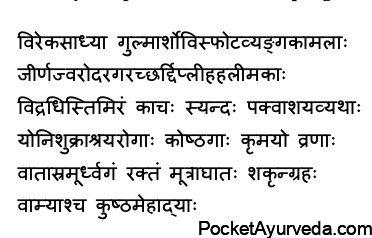

Virechana Yogya – Virechyah – persons suitable for purgation therapy:-
Conditions that require purgation therapy includethose that require purgation therapy. Gulma Abdominal tumors,
Arsha – Piles,
Visphota– blisters, Vyanga – discolored patch on face, Kamala – Jaundice,Liver disease Jeernajwara – Chronic fever,
Udara – ascites, intestinal obstruction, chronic poisoning Chardi – Vomiting
Pleeha – Spleen disease, Splenomegaly
Haleemaka – advanced jaundice
Vidradhi – Abscess
Timira – blindness,
Kacha, Syanda – Cataract
Pain from the large intestine
Female and male urogenital diseases urinary system
wounds/ Ulcers,
Vatasra – Gout,
Urdhwarakta blood disorders in the upper body parts (such like nasal bleeding) Conditions of blood vitiation,
Mutraghata – Dysuria
Shakrut Graham is a remedy for constipation.
People who are suitable for emesis therapy, as enumerated in earlier verses beginning with ” those suffering from Kustha” can be treated. be treated using purgation therapy. 8-10a These diseases include:
Kushta – skin diseases
Meha – the urinary tract, diabetes and other disorders
Apachi, Granthi – Goitre, tumour, fibroid
Shleepada – Elephantiasis, Filariasis
Unmada – Schizophrenia
Kasa – cold, cough
Shwasa – Chronic respiratory tract disease Asthma
Hrullasa – nausea
Visarpa – herpes
Stanyadosha – vitiated breast milk
Urdhvaroga – neck diseases that affect and over region
Contra indication for Virechana – Avirechya – Virechana Anarha – Virechana Ayogya


Contra indication for Virechana – Avirechya – Virechana Anarha- Virechana Ayogya
Navajwara A an illness of recent origin
Alpa Agni – poor digestive activity,
Adhoga Raktapitta A bleeding illness in the lower part of our organs (such as bleeding through wounds to the rectum, ulcers on the rectum
Atisara – diarrhea, dysentery
Sashalya – foreign bodies;
Patients who received decoction-based enemas (Niruha Basti)
Krurakoshta – Individuals who suffer from bowel movements that are difficult to control,
Atisnigdha – who have gone through more than Oleation treatment
Shosha – emaciated 10b-11
Vamana Vidhi- The procedure of emesis therapy
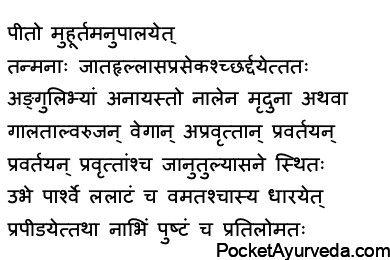

Vamana Vidhi- Procedure of emesis therapy
After the administration of oleation (Snehapana & Abhyanga) and sweating therapy (Swedana) correctly prior to the day that emesis occurs.
The patient is assured that he slept well the night before.
The patient is assured that the food he has eaten previously is easily digested. In the morning the day of Vamana At first, the auspicious rituals are performed.
Then, Kapha Dosha will be stimulated, by giving peya (drink) or a thin gruel that is made of fish, Masha (black grams) Tila (Sesame), and so on. along with a tiny amount of fat in the morning.
He is either fed on an empty stomach or a small amount of ghee can be given.
The elderly children, children, debilitated VIPs, cowards, and debilitated must be encouraged to drink milk, wine juice, sugarcane juice, or meat juice infused with honey or Saindhava salt that is appropriate for the illness, at their full capacity.
Then, after determining the function of his bowels (Intestines – Koshta). and then the Vamana Dravya – (Emetic drug) is administered, sanctifying it by chanting following shloka.
“Let Brahma, Daksa, Ashvinis, Rudra, Indra, the Earth, Moon, Sun, Air, Fire, Sages, comity of herbs, and of living beings protect you; let this medicine be to you like Rasayana for the Sages, Nector for gods and Sudha for the good serpents; Om, Salutations to the medicine.”
After chanting this shloka, he must take the medicine looking to the towards the east. 12-18a
Note: The medication prescribed to treat Vamana is based on the condition. It typically contains Madanaphala (Randia spinosa) Licorice, for instance. Different combinations of Vamana medications are covered in a chapter to follow.
Vamana Vidhi – Procedure of Vamana
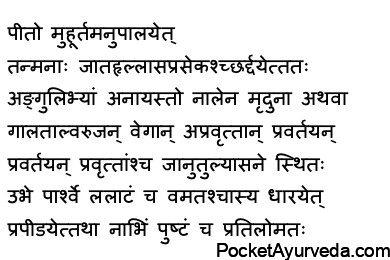

Vamana Vidhi – Procedure of Vamana
After taking the medicine you should sit for one Muhurta (Approx 48 minutes) for the vomiting to begin, with a keen eye.
If there is a feeling of chest pain and salivation, he ought to try to eliminate the bile
If the aches aren’t being triggered easily, the person should try to tickle his throat using fingers or a soft tube, but without causing injury to the throat.
Sitting on a chair at the level of knee. The episodes of vomiting must be with the help of a third person.
The area around the umbilical cord and the back should be massaged in an upward direction. 18-21a


In the event of an increase in Kapha vomiting, it is recommended to be caused by drugs that have properties such as penetrating, hot and pungent (Teekshna, Ushna, Katu);
In the case of Pitta with cool and sweet properties and
In the event of the association of Vata with Kapha or other drugs that have salt, sour, and unctuous properties. (Snigdha Amla Lavana) 21b-22a


Vomiting is allowed until the appearance of Pitta or the complete elimination of Kapha. 22b


If the episodes are not enough, they must be brought on over and over again by drinking boiling water with Kana, Dhatri, Siddhartha, and salt. (long pepper, Amla, white mustard, black salt)
Vamana Ayoga


Non – the beginning of vega, vega that is accompanied by difficulty or even the removal of the medication only are some of the symptoms of Ayoga not having enough bouts. due to it, there is an excessive amount of itching, expectoration, the appearance of skin rashes fever, etc. 23b-24
Samyak Vamana Yoga Lakshana – Proper bouts


Samyak vamana
Kapha, Pitta, and vata are released in succession without any obstruction, peace of mind, and a cessation of vomiting all on their own.
lack of characteristics of insufficient instances and
the sensation of not feeling enough discomfort is the hallmarks of samyagyoga, an appropriate bout.25a
Vamana Atiyoga


Vamana Atiyoga
In Atiyoga, excessive amounts of the material that is thrown up will be foamy, with blood and glistering particles;
The patient may experience weakness as well as burning sensations, irritation of throat and giddiness severe vata-related illness and death due to the discharge of life-sustaining blood. 25b-26
Vamanottara Upachara – Care after vomiting therapy


If the patient has had appropriate episodes of vomiting, he is encouraged to comfort him with positive words and encouraged to breathe any kind of smoke (Dhuma)moderate medium or strong, and allowed to adhere to the protocol of care after Oleation therapy. 27
Vamanottara Upachara


Then, in the evening or in the morning when you feel hungry, after a bath in warm water then he may eat a mass cooked with red rice or if he’s not hungry, he can follow the next regimen consisting of Peya (Thin greek) and others. 28 This is known as the Samsarjana Karma.
Samsarjana – Peyadi Ahara Karma- Ahara Karma- A regimen of liquid Diet


Samsarjana – Peyadi Ahara Karma- Regimen of liquid Diet
Patients who have received the most, medium, and minimum purificatory therapy should consume Peya – thin Gruel,
Vilepi– thick Gruel
Akruta Yusa-Soup that is not made with salt, fat and sours. Kruta yusa – Soup made using salt, fat, and Sours, and
Rasa– meat juice in succession order. 29
Note: Eating periods = Anna Kala.
Each day has two Anna Kala. Morning and evening.
If the highest number of vomiting episodes were detected (Ati Yoga), Then the patient must be taking Peya, Vilepi, Akruta Yusha, Kruta Yusha, and Mamsarasa three times during eating (Annakala) every day. The patient should not eat any other food except for those. In the case of moderate vomiting episodes, the amount of eating intervals is two per day and for smaller episodes (Heena Yoga) The number of eating times (Anna Kala) is one per day.
Benefits of Samsarjana Karma in vamana karma


Benefits of Samsarjana Karma
Like sparks of fire following getting fed with grass the dry cow dung powder and other materials, is gradually increased and then becomes strong, steady and able of burning anything, so too the internal digestive fire, triggered by the Samsarjana regimen when a patient has gone through Vamana karma, gets stronger. 30
Vega Samkhya – Mana- Quantity of Bouts as well as number in Vamana and virechana karma


For Vamana,
Heenayoga – Minimum bouts – 4 bouts.
Madhyama vega – Moderate – 6 bouts
Atiyoga – Maximum bouts – 8 bouts
For Virechana –
Heenayoga – 10 vega, or half prastha from pure materials (384 grams)
Madhyamayoga – 20 bouts one pasta of material (768 grams)
Atiyoga – 30 bouts. 2 prstha (1,536 grams). 3


The vomiting therapy can be continued until the pitta’s expulsion or the elimination of half of the purgations.
The therapy for purgation is permitted until Kapha is released;
Tests are to be conducted after rejecting two to three instances, which contain faeces in Vamana’s case. Vamana and following the rejection of the drug-emetic medicine for Vamana. 32
Virechana Vidhi – Purgation Therapy procedure


Virechana Vidhi- Purgation therapy procedure
Following Vamana treatment, the patient is treated with Samsarjana regimen. Then, he’s again treated with Snehana along with Swedana treatment.
Then, in the morning, once Kapha time has expired (after about 9-10 AM,) Virechana drug should be administered. It is recommended to give the purgation medicine. The quantity and type of purgation medication is the most important factor in determining the quality and severity of one’s Kostha (alimentary tract and the bowels). 33


A person suffering from Mrudukoshta (soft intestinal tracts) only milk may cause purgation.
If you are a patient with Krurakoshta, (hard bowels, intestinal tracts) Trivrit (a herbal remedy for purgation) could cause purgation that causes extreme difficulty. 34
Rasa according to dosha dominance for virechana


To treat Pitta condition, Kashaya – astringent and Madhura sweet drugs can be taken to help purge.
To treat Kapha illness, Katu (pungent) herbs are recommended for purgation.
For Vata and Snigdha, drugs with oily, unctuous Ushna (hot) along with Lavana (salt) tastes are administered to stimulate purgation. 35


If the purgation does not start, he must consume hot water and his abdomen heated by warming the hands. 36a
Repeat virechana karma
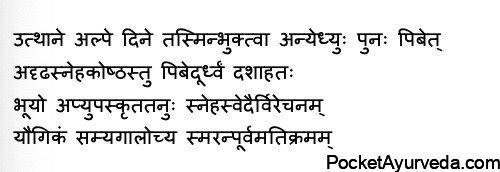

If, after a day that they consume the drug that is purgative when the patient’s response is poor and is not responding well, he should be permitted to eat food the day of his consumption and have the same purgative drug administered on the following day;
People with a troubled and unlubricated digestive tract must consume drugs to purge after ten days in the course of which Snehana and sweating treatments should be administered since the body that has been properly prepared by Snehana and sweating treatments, will be able to experience the purgation that it needs;
The drug that is purgative should be administered after taking into consideration all aspects and recollecting the steps described previously . 36b-38a
Vishama Yogah – Abnormal bouts:-
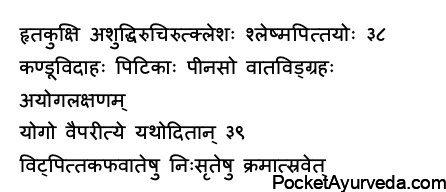





Virechana Vishama Yogah – Abnormal bouts
Virechana Ayoga lakshana , a lesser amount of purgation
Asuddhi of The area of the abdomen and heart,
Aruchi – Anorexia
Too much Kapha and Pitta rise inside the digestive tract (because they’re not properly removed from your body) or the expulsion of Doshas is released through the mouth.
Kandu – itching,
Vidaha – sensation of burning,
Pitika is an eruption of the skin
Peenasa – rhinitis,
Vata Vidgraha – blockage of constipation and flatus
are the hallmarks are the characteristics Ayogais an insufficient bout of purgation therapy
The opposite aspects of proper bouts
In the Case Of Virechana Atiyoga – excessive sessions
After the removal of faeces Pitta, Kapha and vata in the succeeding order There will be the removal of the watery substance that is not containing Kapha or Pitta that is black, white or a little red and resembles the water in which the meat was washed or looking like an ounce of fat
Prolapse of the rectum, hunger, giddiness, and illnesses caused by excessive of vomiting will show up. 40-42


A person who has had an appropriate purgation therapy, must apply all other therapies other than smoking inhalation as listed under emesis therapy. afterward, he must adhere to the diet regimen exactly as emesis therapy, and thereafter resume his regular food. 42- 43


On the day that you consume the purgation
If the patient is suffering from weak digestion (Mandagni) or a sensation of coated in the intestine and the digestive symptoms from previous meals are not evident, patient should be forced to fast. In this way, it is not harmed by the pain due to blockage of Doshas and which is aggravated by oleation and other treatments. 44-45a


The digestive system is weakened due to purification treatments such as bloodletting, oleation, and fasting. Therefore, the diet consisting of Peya and thin Gruel etc. must be followed. 45b-46a
Peya contraindications in virechana


Peya is not recommended in the event that only small amounts from Pitta or Kapha are eliminated for those who are addicted to alcohol and for the case of Vata or Pitta are predominant in their lives. For them, regimens of Tarpana and Kapha. A nourishing treatment is appropriate. 46b-47a


Vamana (Emesis) is the one who brings out Doshas that have not been cooked (processed through heat)
In contrast, Virechana (purgation) can bring out the Doshas that have been through Paka (cooking to process using heating) which is why in cases of emesis, the doctor does not have to wait for Doshapaka (cooking to cook the Doshas). 47


A person who is weak, with a lot of elevated Doshas suffers from purgation on their by himself – without taking purgative drugs; he must be treated with food items that are purgative. 48.


Individuals that are weak have had purification therapy before and who are not suffering from a lot of unbalanced Doshas and are severely emaciated and whose anatomy of the digestive tract is not understood, are advised to receive an emaciated drug with a mild purgative effect in a small amount. It is best to administer in smaller amounts frequently.
A large dose at once can create the appearance of death
Medication in small doses and infrequent dosages can eliminate the Doshas that are circulating slowly for a weak individual the Doshas in small quantities can be controlled with moderate drugs, and they should not be removed through purification therapiest. 49b-51


Doshas that are higher in number, can affect a person greatly , and may might even kill him, in the event that they are not eliminated through purification treatments.
krura kostha vamana and virechana procedures


If you are a person with weak digestion, Krura koshta – hard bowels (hard natural alimentary tract) is a good indication to administer Ghee that has been processed using Kshara along with Lavana (Alkalis along with salts) to increase his digestive capacity, and also to Vanquish Kapha and Vata; afterward, he should be treated with purifying therapies. 52
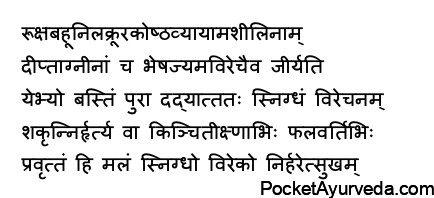

Basti before virechana karma
In people with Rooksha (dry) and who have an increased amount of Vata or who have a tough natured gastrointestinal tract (Krura Koshta) that workout regularly and who possess an excellent digestion capacity the purgative drug is broken down without producing purgation. for these people, an enema must be first administered and after that, a purgative drug such as Snigdha (unctuous, oily) is recommended ;
or the faeces must be eliminated first. This can be done by using a powerful rectal of fruits. Doshas have been triggered to begin their movement. The drugs that purge them out easily. 53-55


Snigdha Virechana karma indications
Patients suffering from poison, Abhighata (Trauma), Pitika(skin eruption), Kushta – skin conditions, Shopha (inflammation), Visarpaherpes Kamala (Jaundice), Anaemia and Diabetes and should receive the purgative treatment with a minimum of Snehana(oleation. Mild oleation is enough for these. Everyone must be treated with fat-based purgatives. Those who had previous oleation should receive dry non-fatty purgatives. 56


Notice: Virechana is of two kinds. Snigdha Virechana and Rooksha Virechana.
Snigdha Virechana Snigdha Virechana is made by purgatives made of fat, like castor oil. The fatty substance is blended with other herbs. For example, Castor oil, which is mixed with haritaki.
Rooksha Virechana Rooksha Virechana in which only dry purgative herb is used. For example, Trivrit Lehyam.


Doshas that are loosened from the body via oleation, as well as the elimination of sweating through purification therapies, similar to the dirt removed from the cloth, is eliminated through washing. 58


The body of a person who uses cleanse therapies without having to undergo Oleation or Sweating regularly breaks just as a dry piece of wood when bent.
Shodhana Phala- benefits of Purification therapies:


Shodhana Phala- benefits of Purification therapies
Clearness of thought, strength of organs that sense, the strength of tissues, and a keenness in digestion strength and slow ageing result when purification therapies are when properly carried out. 60
The chapter is now complete. Vamana Virechana VidhiThe 18th Sutrasthana from Astangahrdaya Samhita.
FAQ’s of Vamana Virechana vidhi adhyaya
which panchakarma procedure is ideal for which dosha?
vamana-kapha dosha, virechana-pitta, basti-vata
in which conditions vamana karma is indicated?
Navajwara,Atisara,Adhoga Raktapitta,rajayakshma,meha,apachi,geanthi,shleepada,unmada,kasa,shwasa,hrullasa,visarpa,stanyadosha,urdhvaroga
in which conditions vamana is contra \indicated?
garbhini,rooksha,hungry,nitya dukhi,children,elders,krusha,sthula,hrudrogi,kshata,durbala,nausea,pleeha,timira,krimidosha, udhwaga raktapitta, loss of speech, dysuria,udara,arsha,urdhva vata,giddiness,parshva vata,indigestion
what are the indications of virechana karma?
gulma,arsha,vishphota,vyanga,kamala,udara,intestinal obstruction,chronic poisoning,chardi,pleeha,haleemaka,vidradhi,timira,cataract,pain in large intestine,urdhwaga raktapitta,mutraghata,all vamana suitable diseases
what are the contraindications of virechana karma?
navajwara,alpa agni,adhoga raktapitta,atisara,sashalya,niruha basti,krura koshta,atisigdha,shosha
what if sufficient vega are not produced in vamana karma?
drink boiled water with Kana, Dhatri, Siddhartha, and salt. (long pepper, Amla, white mustard, black salt)
vamana is done until?
pittanta, untill appearance of pitta.
after vamana dravya how much once should wait?
till one muhurta, approx 48 minutes
what are the symptoms of vamana ayoga?
Itching,Expectoration, skin rashes and fever
what are the samyaka vamana lakshana?
expulsion of Kapha,Pitta and vata in a order without any obstruction, peace of mind, and cessastion of vomiting by its own. no any discomfort.
what are the symptoms of vamana atiyoga?
eliminate excessive amount of fluid foamy with blood and glistering particles, severe weakness, burning sensation, irritation of throat and giddiness, vata related illness and death.
what is the paschatkarma after vamana?
dhumapana and sansarjana karma


